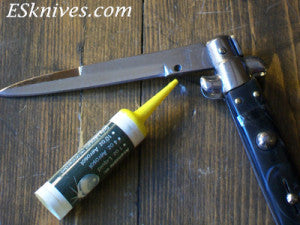Sword Terms
Terms used to describe the Japanese Sword Blade
| Aikuchi | Small tanto (knife) without a tsuba (hand guard). Carried concealed inside the clothes, often by women. |
| Ashi | Small channels of softer steel extending from the ji into the hamon. Literally "Legs". This irregularity in thehamon is said to prevent large sections of the cutting edge from being broken off at any one time. |
| Ayasugi | A type of jihadda of regular wavy lines produced by selectively filing away sections of the masame patterned steel block when the blank for the sword is being made. |
| Bo'hi | A wide groove or Hi. |
| Boshi | Pattern of the hardened edge on the point. |
| Choji | Clover or mushroom shaped hamon. |
| Chokuto | Straight sword |
| Gunome | Semi circular wave shaped hamon. |
| Ha | Cutting edge |
| Habuchi | The line defining the edge of the hamon, the transitional zone from hard to soft steel. |
| Hada | Forging marks |
| Hamachi | Notch marking the beginning of the sharpened edge |
| Hamon | The pattern of the hardened, martensite steel as it shows on the side of the blade including the transition zonehabuchi to the softer pearlite steel. |
| Hi | Groove in the upper side of the blade. |
| Hitasura choji | Choji shaped hamon, with a mottled blade. |
| Horimono | Carving or engraving on the blade |
| Inazuma | Streaks of hardened steel in a vertical zig-zag pattern in the transition zone habuchi. Literally means "lightning bolts". |
| Itame | Wood-like grain in the steel, produced by using the hammered face of the forged steel block as the side of the blade. It is similar to the side grain in a block of wood, with irregular rounded shapes. |
| Ji | Blade surface above the hamon |
| Jihadda | Pattern on the surface of the blade or ji. |
| Jitetsu | The color and texture of the steel as seen on the surface of the blade or ji. |
| Katana | The katana replaced tachi in the middle of the Muromachi period and was in use until the very end of the Edo period. They were 60.6 cm (2 shaku) long or more. Often worn as part of a pair of swords with a shorterWakizashi during the Edo period. Displayed blade up. |
| Ken | Straight sword made in early Japan. It was replaced by the tachi in the Heian period. |
| Kinsuji | Horizontal streaks of hardened steel in the transition zonehabuchi. Literally means "golden lines". |
| Kissaki | Point of Sword |
| Ko Nie | Small particles of hardened steel, martensite crystals, in the habuchi between the size of nie and nioi. |
| Ko notare | Shallow irregular undulations in the hamon. |
| Masame | Wood-like grain in the steel, produced by using the un hammered edge of the forged steel block as the side of the blade. It is similar to the end grain in a block of wood, with fine regular lines that are closely spaced. |
| Mei | Signature of the Sword Smith |
| Mekugi ana | Peg hole in the tang |
| Motohaba | Width at machi |
| Mune | Back surface |
| Mune-machi | Notch at back marking top of tang |
| Nagasa | Length of the blade |
| Nakago | Tang or handle end of the sword. |
| Nie | Small particles of hardened steel, martensite crystals , in the habuchi large enough to be seen with the naked eye. |
| Nihonto | Japanese Swords. Includes ken, naginata, yari, tachi, katana, wakizashi and tanto. |
| Nioi | Small particles of hardened steel, martensite or perlite, in the habuchi, too small to be seen individually with the naked eye. They appear as misty areas. |
| Notare | Irregular undulations in the hamon. |
| Omote | Front |
| Sakihaba | Width at yokote |
| Shinogi | Ridge line, defining the edge of the blade |
| Shinogiji | Blade surface above Ridge line |
| Sori | Amount of curvature of the blade |
| Suguha | Straight hamon. |
| Suriage | A shortened tang often due to shortening a tachi to akatana. |
| Tanto | A knife, shorter than a wakizashi. |
| Tachi | Long sword used by the early Samurai from horse back. From the Heian through the early part of the Muromachi period. Tachi usually have a high curvature, sori, and the length is usually between 65 and 70 cm. Displayed blade down. |
| Togi | The polish of the blade. This goes beyond sharpening the blade to a fine finnish to the steel that allows the features of the steel to be seen. |
| Toran | Wave shaped hamon. |
| Ura | Back |
| Utsuri | Whitish effect on blade surface, ji outside of the hamon. Literally means "reflection" and may follow the lines of the hamon. |
| Wakizashi | Shorter sword worn as a pair with the longer katana. The cutting edge is between 12 inches and 24 inches in length. Displayed blade up. |
| Yakiba | Cutting edge |
| Yasurime | The file marks on the nakago (tang) |
| Yokote | Line dividing point from body |
Terms used to describe the Japanese Sword Mounting
| Fuchi | Collar of the Hilt, near the tsuba |
| Habaki | Metal Collar used to prevent the sword from touching the inside of the saya |
| Ito | Braid wrapped on the hilt to hold it to the tang. It is wrapped over the menuki to hold them in place. |
| Kashira | Butt cap on the end of the hilt. |
| Koshirae | The entire sword mounting including the saya, tsuba, tsuka, menuki, habaki, kashira, sageo and other fittings. |
| Kurikata | Knot used to tie the sageo to the sword scabbard. |
| Medugi | Peg used to affix the tsuka to the tang |
| Menuki | Ornament placed over the peg that holds the hilt to the tang |
| Sageo | Cord used to tie the sword scabbard to the belt while being worn. |
| Same' | Ray skin used to cover the hilt. |
| Saya | Scabbard |
| Shirasaya | Plain wooden "resting" scabbard used to store a blade |
| Tsuba | Sword Guard |
| Tsuka | Hilt or Handle |
Sword Making Terminology
| Age gitae | Finnish forging. Several pieces of steel formed in the foundation forming shita gitae are folded together several more times. |
| Denkai tetsu | Iron made from scrap iron in an electrolytic furnace, it is 99.99% pure iron. The smith adds the appropriate amount of carbon in his forge using the process of oroshigane. |
| Hagane | Harder (higher carbon content) steel used just for the cutting edge of the blade when it is constructed in thehon sanmai gitae method. |
| Hizu-kuri | Shaping of the blade from the sunobe. The blade is heated and beaten to shape a small section at a time. The blade will be ready for shiage next. |
| Hon sanmai gitae | A less common form of sword construction, using three pieces of harder steel kawagane for each side of the blade a piece of soft shingane as the core and a special piece of harder steel hagane for the cutting edge. |
| Kera | The raw steel produced in the tatara. About half of the steel is tamahagane and ready for use to make a sword. The remaining steel can be used after the carbon content is adjusted by oroshigane in the smiths forge. |
| Kaji-oshi | Final shaping of the blade with a draw knife, files and rough polishing done by the smith. |
| Kangan tetsu | Sponge iron made in the smelter without oxygen. The smith adjusts the amount of carbon in his forge using the process of oroshigane. |
| Kawagane | Harder (higher carbon content) steel used as a starting material to make the body of the sword. The carbon content is between 1.0 and 1.5 percent. |
| Kitae | Forging or folding the steel bar to prepare it for making the blade. |
| Kobuse gitae | The most common form of sword construction, a jacket of kawagane with a piece of soft shinganecore. |
| Nakago-shitate | Finishing the tang with a file |
| Omura | The omuna stone is pulverized into a powder used in the clay slurry the sword is coated with duringtsuchioki. |
| Oroshigane | The process used to adjust the carbon content of steel using the forge. The carbon level is increased by heating the steel starting at the top of the charcoal in the forge and continuing to burn new charcoal until the steel has reached the bottom. The carbon content of steel is reduced by placing it around the air vent at the bottom of the forge and heating it so that the oxygen combines with the carbon in the steel and is exhausted as carbon monoxide. |
| Satestu | Iron oxide sand used in the smelter to make the steel. |
| Sen | The draw knife used to shape the blade. It is made with a very hard steel blade and works like a plane, scraping away thin layers of metal with each stroke. |
| Shiage | Shaping the blade with a draw knife and file. The surface of the blade is prepared for the application of the clay in tsuchioki. This is done after hizukuri. |
| Shingane | Core steel. Softer (lower carbon content less than 0.5%) steel used to make the core of the sword. |
| Shitagitae | Foundation forging. The first six folds during the forging process. |
| Soriaoshi | Adjusting the curvature of the blade, following yaki ire. |
| Sunobe | Blank steel bar, ready to be forged into a sword. |
| Tamahagane | Raw steel used to make the body of the blade. |
| Tatara | The smelter. It burns charcoal with iron oxide sand to form the tamahagane. |
| Tanren | The process of welding together several smaller pieces of steel into a single block, then it is hammered flat and folded twelve to fifteen times normally cross-wise. This creates the jihadda of the finished sword. |
| Tsuchi-oki | Coating the blade with a slurry containing clay, charcoal powder and pulverized omura stone, prior to hardening. The thickness of the clay coating determines the speed of cooling when the hot blade is quenched in water during yaki ire. The portions of the blade that cool quickly form hard steel structure, the portions of the blade that cool slowly convert back to the softer steel structure. This determines the pattern of the hamon on the finished sword. |
| Tsukuri-komi | A soft core of shigane is placed in a groove in the steel formed during tanren. This is then used to form the sunobe. The shigane or soft steel has been forged previously. This core of softer (lower carbon content steel) in the blade gives the sword resilience and helps prevent the sword from breaking. |
| Tsumiwakashi | Assembling the Steel Bock for forging. Small pieces of kawagane are piled into a stack, they are wrapped in paper and dipped in clay slurry. This is heated and beaten to weld it into a single piece of steel and drive out impurities. |
| Yaki-ire | The hardening of the steel by heating and quenching in water. The cutting edge of the blade has a thin coat of clay while the rest of the sword has a thick coating of clay. When steel is heated to between 700 C to 900 C the crystalline steel changes to the structure called austentite. When it is cooled quickly, where there is thin clay, it changes to martensite. The rest of the steel cools slowly enough that it changes back to it's original ferrite or pearlite forms. The blade also gets most of it's curvature due to the differential expansion of the thin edge and the thicker back of the blade. |
| Yaki-modoshi | Tempering the blade to relieve internal stresses afteryaki ire. The blade is heated to about 150 C and quenched in water. |
Terminology used to talk about Sword Smiths
| Ningen Kokuho | National Living Treasure or (Designated as the Owner of the Important Infinitive Cultural Asset) |
| Masamune prize | Supreme prize awarded to the best submission by a Mukansa Smith at the annual Sword Making Competition |
| Mukansa | A Swordsmith who has been promoted above the general Sword Making Competition and is only judged against other Mukansa. |
Other Terms used when identifying the origin of a sword.
Kantei
| Ato Mei | A signature of a sword smith added latter, not by the smith himself. These are considered to be correct, and do not match the smiths signature on purpose. The features of the sword itself, support this attribution. |
| Bizen | One of the five regional traditions of Japanese Sword making. |
| Dai Mei | A blade made by a master smith and signed by the student who assisted. |
| Dai Saku | A blade made by a student under the direction of a master smith and signed by the master. This is often considered to be equivalent to the work of the master. |
| Gendaito | Modern or contemporary swords made after 1876 or so. |
| Go Kaden | The five traditions of Sword Making. Usually a sword can be placed in one of the five tradtions as the first step in Kantai. |
| Gimei | A false signature Mei, added to the sword in an attempt to deceive. |
| Gunto | Swords made for the Japanese Military during World War II. Often they were not made in the traditional way. |
| Kantei | The act of identifying the origin of a blade. This includes the time it was made, the place and the smith who made the sword. |
| Koto | A sword made before about 1573. |
| Mumei | A sword without a signature from the smith. |
| Mino | One of the five regional traditions of Japanese Sword making. |
| Oshigata | A rubbing or drawing of the sword showing it's features. It may be of the entire blade or only the nakago (tang) to show the mei (signature). |
| Shinsakuto | Newly made sword. |
| Shin Shinto | A "new new" sword made between about 1772 to 1925. |
| Shinto | A "new" sword made between about 1573 and 1760. |
| Sho shin | A true and genuine blade (or other item). |
| Soshu | One of the five regional traditions of Japanese Sword making. |
| Yamashiro | One of the five regional traditions of Japanese Sword making. |
| Yamato | One of the five regional traditions of Japanese Sword making. |












